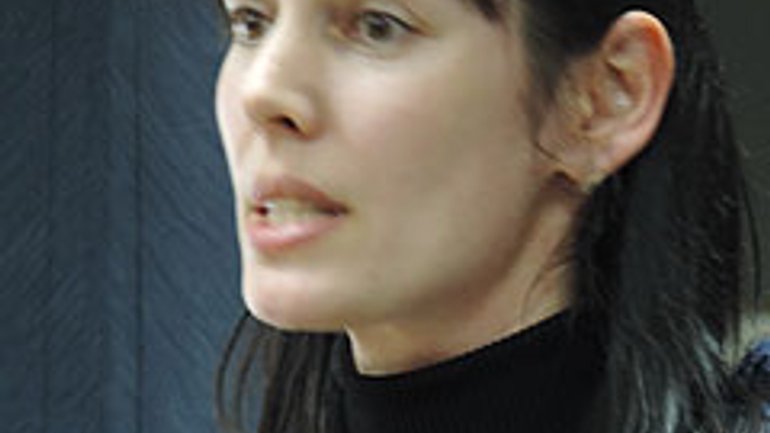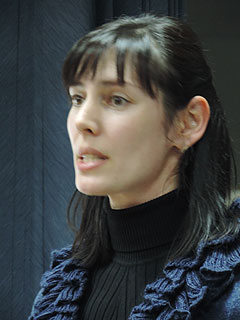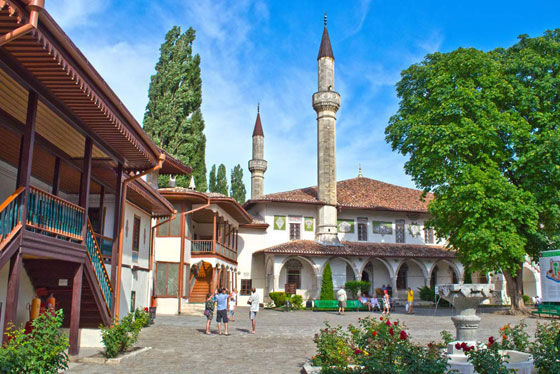Islam in Crimea: golden past and uncertain present

 If anyone from the mainland of Ukraine wishedto see a variety of mosques, he knew the answer –he had to set off for Crimea. However,thespring events of this year made their adjustments into the life of Muslims of the peninsula. Interrogations, searches and even killings are the consequences they now have to put up with. PhD in Political Science, Associate Professor of Vernadsky Tauride National University Elmira Muratova told about the history of Islam in Crimea.
If anyone from the mainland of Ukraine wishedto see a variety of mosques, he knew the answer –he had to set off for Crimea. However,thespring events of this year made their adjustments into the life of Muslims of the peninsula. Interrogations, searches and even killings are the consequences they now have to put up with. PhD in Political Science, Associate Professor of Vernadsky Tauride National University Elmira Muratova told about the history of Islam in Crimea.
The lecture by the famous religious scholarstarted with periodization of the history of Islam in Crimea. Elmira Muratova divides it into the following periods: Islamization of Crimea (13-14 centuries), Islam of the Crimean Khanate period (1443-1783), lifein Tauride Province (1783-1917), the Soviet period (1918-1944), the deportation period (1944-1989) and the revival of modern Crimea (1990 to present). We offer a brief overview of these historical milestones in the history of religious Crimea.
Islamization of Crimea (13-14 centuries)
Mentions of the emergence of Islam in the Crimea date back almost to the lifetime of the Prophet Muhammad, as some chroniclers write. We now know that Muslim merchants and missionaries from Central Asia and Iran came to the peninsula as early as in the 8th century, and remained there until the 12th century.
The author of chronicles Ibn Bibi stresses that Islamization of the peninsula began in the 13th century. Later, in the city of Solkhat (Old Crimea) this process was supportedand developedby Berke Khan. Later, in 1255, the first Crimean dervishes, representatives of the Sufi Babai movement appeared. In 1263 the first mosque was built.
Uzbek Khan (1312-1340)continued the construction of places of worship, during his tenure the mosque in Solkhatwas built. It is in 2014 that it marks exactly 700 years of its construction, but now it is in a wretchedstate and can be destroyed unlessthe reconstruction begins. At the same time in Crimea theconstructionof the first madrassas (Islamic schools) gained popularity, the ruins of one of them still remain in the peninsula.
Islam of the Crimean Khanate period (1443-1783)
In 1443, the Crimean Khanate was founded and its golden age lasted until 1783. At the same time in 1475 the Khanate acquired the status of vassalage of the Ottoman Empire, which did not prevent its development. As a resultof this political decision, the position of Islam only strengthened and Sultan performed a role of spiritual leader for Muslims.
In this very period, Islam became the state religion and the process of ethnic genesis of the Crimean Tatars was developing, as they became a unified ethnicity. At the same time, Islam cemented the people. New institutions emerged on a large scale: mosques, madrassas; a system of hierarchy of the ministers – muftis, Kazasker (supreme judge for military and religious matters), imams, Khatibs (a chaplain, who performs Friday prayer).
During the Golden Age the culture of Crimean Tatars reaches new heights, creating a galaxy of eminent scientists. In particular, leading scholars of Saudi Arabia have referred to their research papers up to the present, citing the works of the XIV century.
Life in Tauride Province (1783-1917)
On April 8, 1783, the Golden Age of the Crimean Khanate ended as the peninsula joined the Russian Empire, and in 1802 the Tauride province was founded. This period of life in Crimea was marked by oppression of Crimean Tatars in the economic and religious life. This resulted in two emigration wavesof 1778-1785 and 1859-1861.
However, in 1794, the Tauride Spiritual Directorate of Muslims was established as the main regulating body.

However, the 19th century is considered ‘black’ for the culture and science of Crimean Tatars, as they experienced a decline. Ismail Haprynskyi (1851-1914) tried to change this situation with his concept of development of the Crimean Tatars. According to him, significant changes can be achieved only through education, so he took up the reform of this sector and argued that Muslims should be an example for all others.
Crimea during the Soviet period (1918-1944)
The First World War and the subsequent revolution created new conditions for the Empire and the Crimea. This period was marked by even greater problems for the Crimean Tatars and Muslims. In 1923, the People's Directoratefor the Muslims of Crimea was founded,and Ibram Harni became Mufti for that time.
The main problems concerned the funding of Muslim organizations, religious education at mosques was allowed only starting from the age of 14 given the payment by students’ parents. In addition, in this period the alphabets have been replaced–the Arabic for the Latin, and later for the Cyrillic alphabet.
The authorities constantly exerted pressure on believers through taxation of religious communities. Later they began closing the mosques, and the training center for imams ceased to exist. By 1939 the course of the closing mosques brought its fruit: while in the 18th century there were 1600 mosques on the peninsula, on the eve of the Second World there were only 792 of them left.
During the German occupation, Crimea became ambiguous for Crimean Tatars. It was at this time that 50 mosques were reopened, and Muslim committees were established to intensify their work, newspapers and magazines, theaters were opened too.
The result of this historic turning point was the deportation of Crimean Tatars on May 18, 1944. While atheist policy intensified on the peninsula, the popular religion remained at the ritualistic level.
Revival of modern Crimea (1990 – present)
The sign of revival of Islam was the opening of the spiritual centers of the Muslim community, recovery, reconstruction and opening of mosques, madrasas, Koran schools. The factor of political mobilization of Crimean Tatars and the introduction of Islamic norms in everyday life also contributed to the process.
The “official” structure of Islam in Crimea is represented by the following organizations: the Spiritual Directorate of the Muslims of Crimea(SDMC) since1992, which has more than 400 communities; the Spiritual Center of Muslims of Crimea (2010). “Unofficial” Islam is represented by Salafists, Hizb ut-Tahrir and the “Muslim Brotherhood” organizations.
Currently 323 mosques (95 of them new), eight madrasas, 80 Koran (Sunday) schools and Muslim charities are functioning. At the same time the attitude towards Islam remains controversial, although most people identify themselves as Muslims. The recent studies indicate that only 7.5% of Crimean Tatars pray 5 times a day. In general, 22.8% do it at least occasionally.
The vast majority of residents perceive Islam rather as cultural tradition (79.5%), and 18% are ready to call themselves deeply religious. Interesting enough that only 0.5% of Crimean Tatars can call themselves atheists–so one may not speak about secularization. According to Elmira Muratova, the general conclusion is that people remain believers, but do not understand their faith as exercise of religious norms. An important factor is the fact that unlike the Russian federation, the Ukrainian authorities actually did not interfere in the affairs of Muslims. There were only a few attempts to influence the community through parallel structures, but without consistency and cruelty. However, there was some support for policy of developmentfor Islam,therefore everything depended on most religious communities.
After the annexation of Crimea by Russia, the reality have changed dramatically, underlines Elmira Muratova. As she recalls, first there was a state of shock, which was replaced by fear and uncertainty. Searches of mosques and homes of Crimean Tatar, review of literaturein madrassas and charges of mosques in "extremism" became a regular practice. However, the searches in houses and apartments went far beyond simple checking of the literature – often they were searched for weapons and drugs.
Such actions become public only in September; previously they were carried out covertly. In parallel, the Spiritual Directorate of the Muslims of Crimea was subject to pressure along with the emergence of the Tauride Muftiate, who claimed forthe true interpretation of Islam. In addition to searches and harassment the cases of kidnapping also took place. They were mostly young Crimean Tatars, some of which were found dead with signs of torture.
Majlis was actually incapacitated after the deportation of two of its leaders. Elmira Muratova recalls that all the time Crimean Tatars lived like in a parallel reality –it seemed it would come to an end soon. Currently new Crimean authorities announced the termination of any harassment or checks by January 1. But in the new year with the laws of the Russian Federation enter n force– and this is a disappointing forecast for Muslims of thepeninsula.









